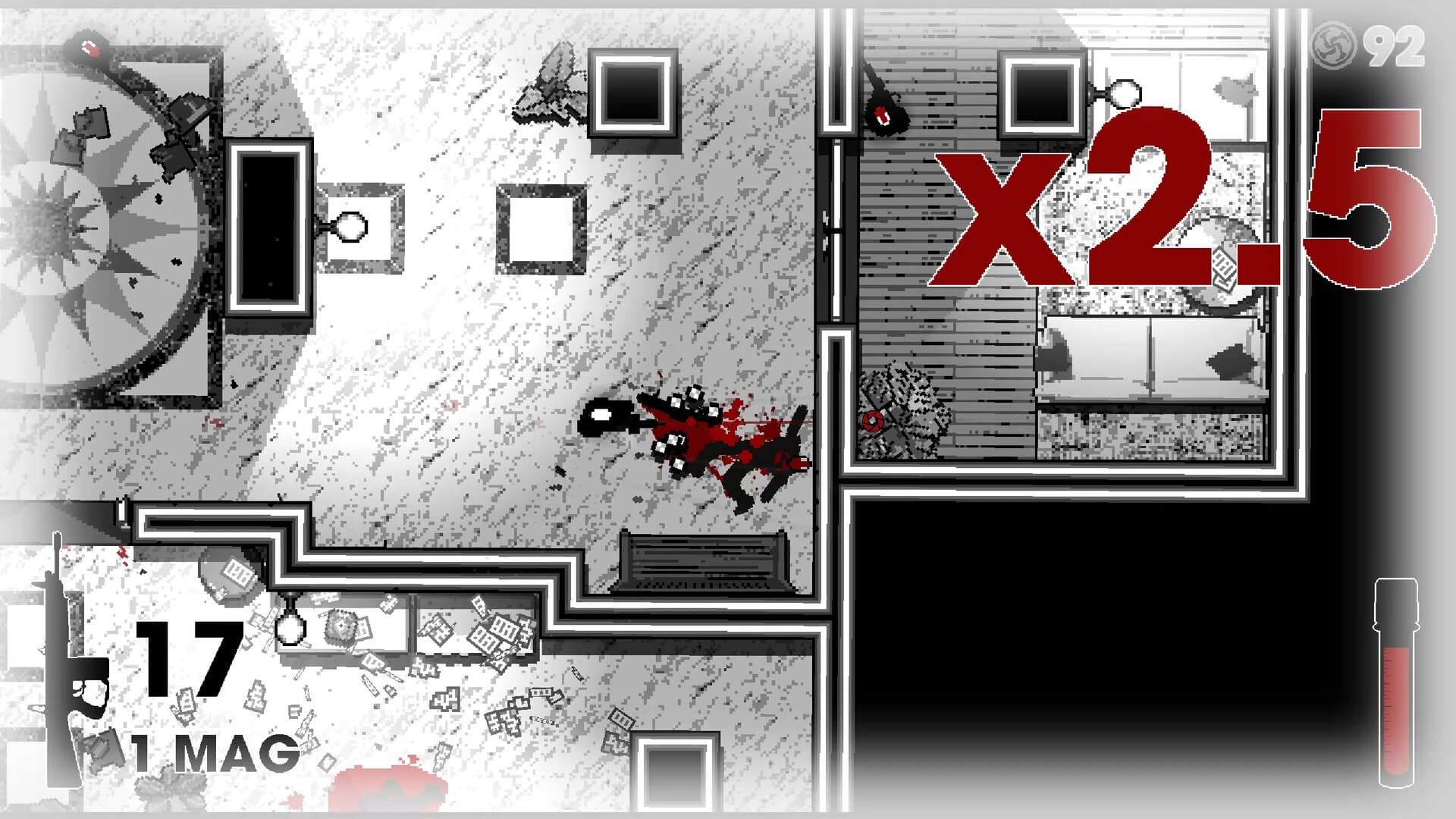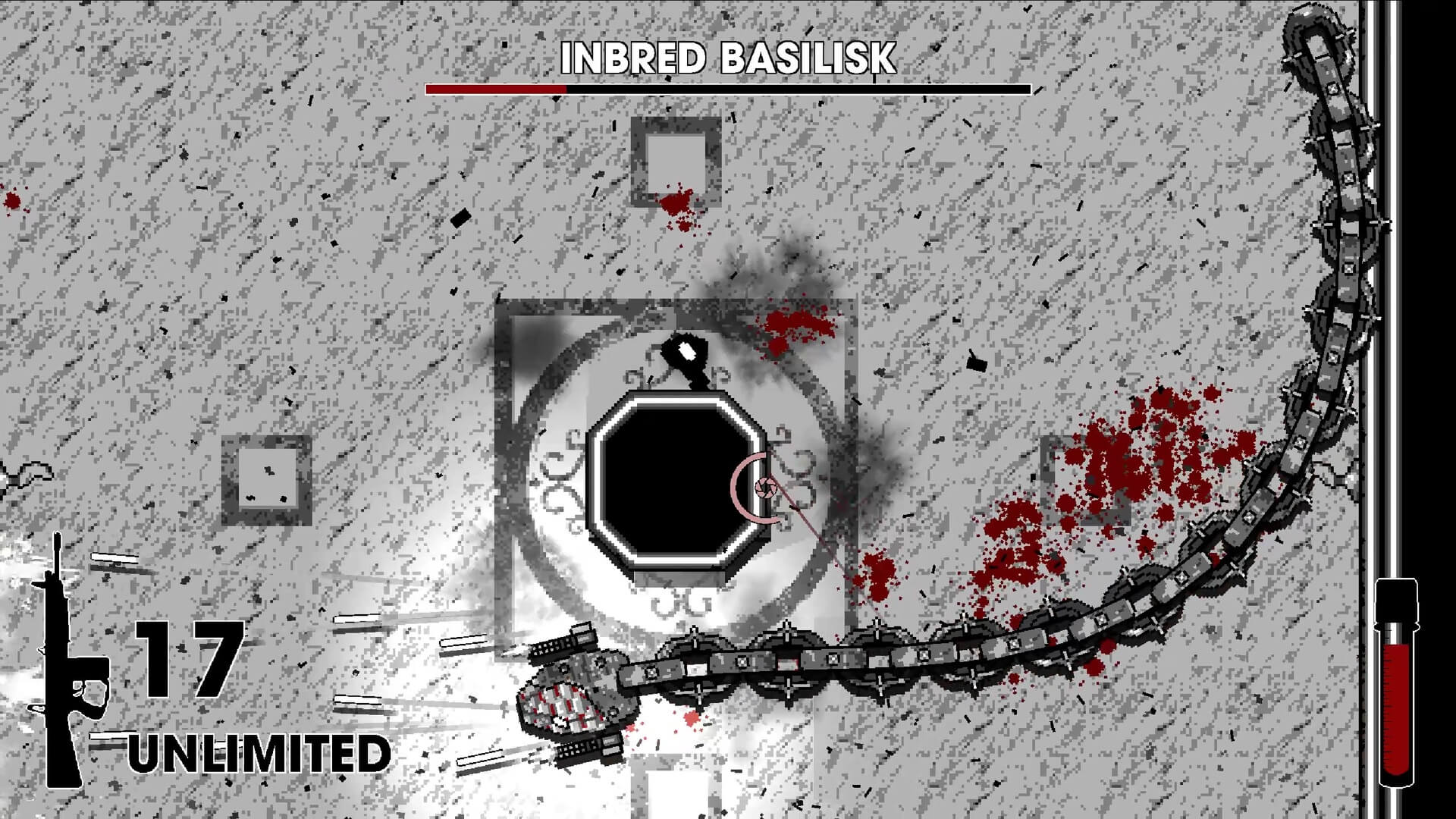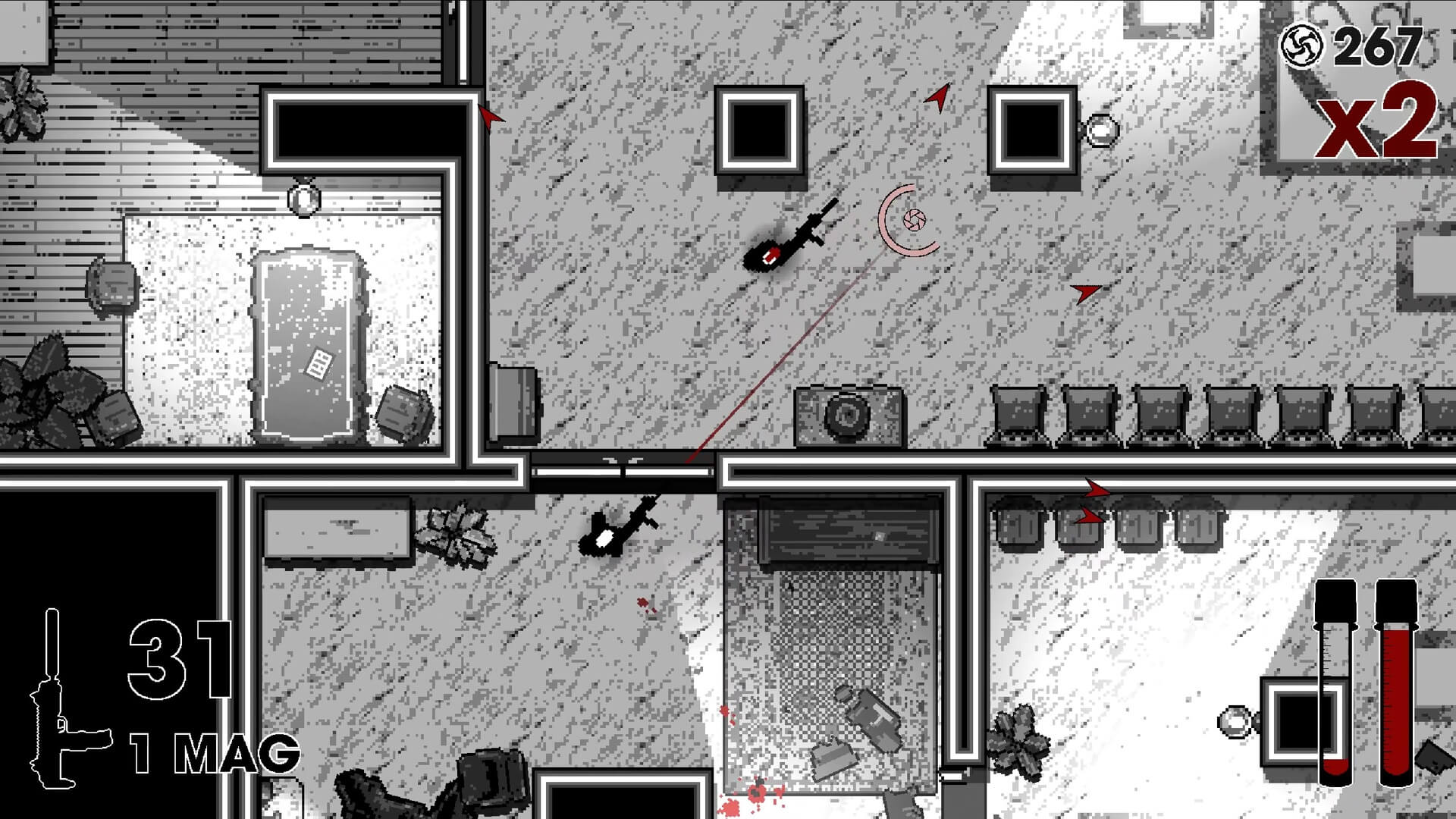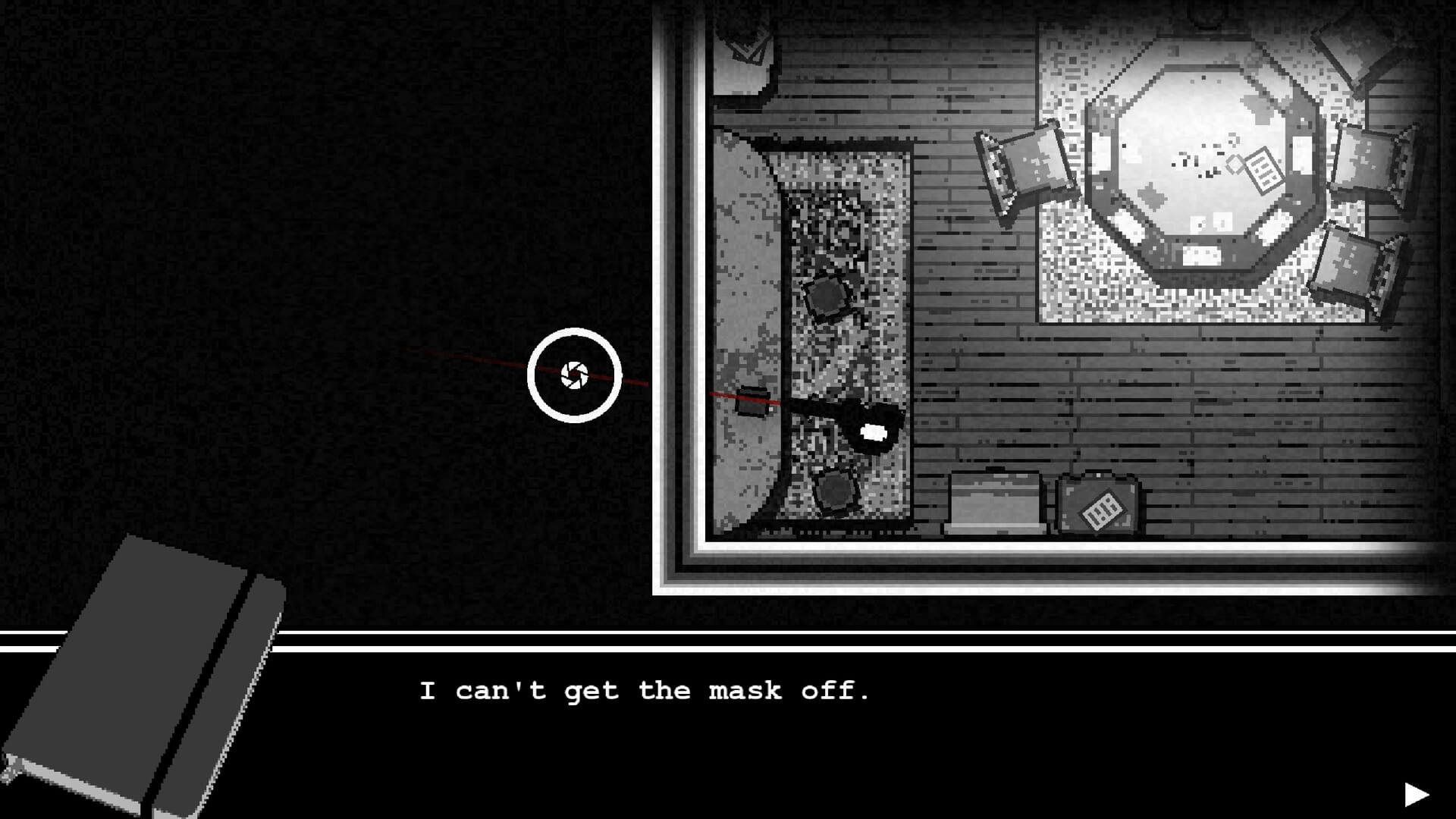If you’re a regular public transport user, you’ll know that there are certain kinds of annoying passengers that pop up regularly. The guy who manspreads across two seats and won’t move. The person who’s loudly listening to their music or taking a phone call. The man who drops a mysterious mask that compels you to put it on, after which you wake up outside a mansion whose rooms constantly shift and whose inhabitants want you dead. That last one might just be in Otxo, the new game by Dogworld developer Lateralis Heavy Industries, but hey, it only takes once.
Let’s not beat around the bush: Otxo is very heavily inspired by Hotline Miami. It’s an obvious comparison, but Otxo wears it proudly on its monochromatic sleeve. Lateralis’ game is a top-down, hyperviolent shooter with fast-paced movement mechanics in which you kick down doors, clear rooms of enemies, and watch as their blood splatters across the floor. Underneath the layers of gore and stylish combat, there’s a psychological narrative in which it’s potentially implied that your character may or may not be undergoing some kind of psychotic break. Can Otxo do enough to distinguish itself from its influences?
Otxo Is A Ridiculously Fun Shooter

There are a few key differences that mark Otxo out from Hotline Miami. For one, it doesn’t have the drug-addled hyper-neon color scheme of its closest cousin, instead choosing a monochromatic look that makes it feel like Max Payne by way of MadWorld. For another, Otxo is a roguelike, and a pretty hardcore one at that. What that means in practice is that Otxo focuses far less on moving through a linear narrative and far more on mastering its core gameplay.
Luckily, that core gameplay is excellent. Otxo‘s shooting is fast, fluid, and responsive. Kicking down doors and eviscerating crowds of bad guys is cathartic and satisfying. Otxo is more focused on firearms than Hotline Miami‘s depraved lead pipe hoedown, so you’ll be shooting a lot of dudes. To facilitate that, Otxo‘s enemies all drop their weapons when they die, and you’re encouraged to grab weapons from the ground instead of reloading your own.
This leads to a frenetic dance in which you’re constantly blasting enemies, swapping your weapon for their old one (which now inexplicably has full ammo), and firing away again. Otxo refuses to let you stand still for even a moment, since if you do, you’re dead. You’ll have to master its fluid, graceful combat if you want to stand even the slightest chance of making it to the core of the imaginatively-named Mansion and rescuing your sweetheart (assuming that is, of course, the actual goal – it’s a little fuzzy, like most things in Otxo are).
In order to help you do so, you’ve also got access to a Focus bar, which slows down time Max Payne-style and gives you a chance to react to the endless waves of bullets being fired at you. Slowing down time, diving through an enemy’s bullets, and separating his head from his shoulders are never boring. My only gripe with the Focus system is that the recharge speed is a little stingy. You will need to be in Focus almost constantly to survive Otxo, especially later on, but Focus recharges so slowly that Otxo accidentally incentivizes simply standing still and doing nothing while you wait for it to come back. That feels at odds with Otxo‘s frenetic, constantly-moving combat.
After A While, Otxo Gets Repetitive

It’s good that Otxo‘s core combat is so compelling because that’s really all the game has to offer. Unlike some other roguelike or roguelite games, you don’t unlock permanent upgrades between runs. Instead, you periodically pick up tonics that serve as temporary buffs during runs, and you can contribute excess money towards unlocking new tonics for future runs.
This is a solid system in theory, but in practice, it’s pretty lackluster. Some of the tonics feel so essential that it almost feels like they should be permanent upgrades, while others are pretty much useless. I never found a use for any tonics that revolved around grenades or kunai, simply because Otxo‘s firearms feel so good to wield that I never really wanted to use any other kind of weaponry. Unfortunately, the tonics you can select are generated randomly, and while you can pay to reroll them, it’s rarely worth doing so. Instead, some runs just feel a little cursed by bad luck.
The problem is one of framework. Otxo is a pure roguelike experience; while there is an ending to be found, it’s buried beneath increasingly difficult layers of bad guys, and one mistake sends you right back to the start with pretty much nothing to suggest you ever made it that far. Since there aren’t any permanent upgrades, you’re reliant on the weapons enemies drop, so you can’t really experiment with new builds, either.
This means that Otxo‘s core moment-to-moment combat is really all the experience has to offer. If you never get tired of shooting Otxo‘s endless waves of masked mooks, you’ll love every second of your time with it. If you’re clamoring for something extra, you’ll have to keep clamoring, unfortunately. There are extra weapons to unlock, but they’re obtained through the random gachapon rooms that you only occasionally happen upon, and they don’t feel like they modify the core gameplay in any significant way. Make no mistake: combat is all Otxo has, and it does start to feel monotonous after a while.
Something Kept Me Coming Back To Otxo

Even though Otxo doesn’t have much beyond its core combat, the refinements it makes to the Hotline Miami formula mean this is hardly an issue. Otxo isn’t shy about its influences; it’s Hotline Miami meets John Wick, with a liberal dash of Max Payne and more than a whiff of Killer7. That’s quite the cocktail, so it’s impressive that Otxo manages to create such a compelling and addictive core loop without dropping the ball in terms of difficulty.
Perhaps Otxo‘s finest feat is that although there are no permanent upgrades, I constantly felt a sense of improvement with each successive run. It was most palpable when I returned to the opening areas after dying on the sixth or seventh floor. The first few levels were pretty tough while I was learning the ropes, but after enduring later levels, I was gliding through earlier stages and boss fights with nary a speck of damage to show for my efforts.
Of course, some of that is because Otxo‘s boss fights are a little lacking. Compared to the constant desperation and skin-of-your-teeth survival of the levels themselves, bosses almost feel like a reprieve, which may or may not have been intentional. They’re intriguingly-designed and they often add to the lurking undercurrent of psychological horror Otxo never quite commits to, but in mechanical terms, I didn’t find them particularly interesting.
That lurking undercurrent is another aspect that sets Otxo apart from Hotline Miami. While certain narrative sequences in Lateralis’ game feel cribbed wholesale from Miami, there’s a more personal and less psychedelic feel to the story. The metaphor of the Mansion is perhaps a little on-the-nose – depression sure does suck, huh? – but the fragments of narrative Otxo drip-feeds, combined with the disturbing design of many of the bosses, provides just enough incentive to keep going when things get repetitive.
Otxo | Final Thoughts

I really enjoyed my time with Otxo. It’s not as original as Hotline Miami (obviously; since it cribs so heavily from Dennaton’s influential shooter, it couldn’t be), but it finds a way to iterate and expand on that venerated indie hit’s formula while still building an identity of its own. Otxo has very little to offer beyond its core gameplay loop, and it gets repetitive after a while, but it’s responsive and fluid enough that you’ll find fun during shorter play sessions. Fire it up in short bursts, like, oh, say, when you’re on the train. Just beware of masked men.
Otxo was reviewed on PC via Steam with a copy provided by the developer over the course of 10 hours of gameplay. All screenshots were taken during the process of review.
Otxo Review
Source: Pinay Guide Blog
Walang komento:
Mag-post ng isang Komento